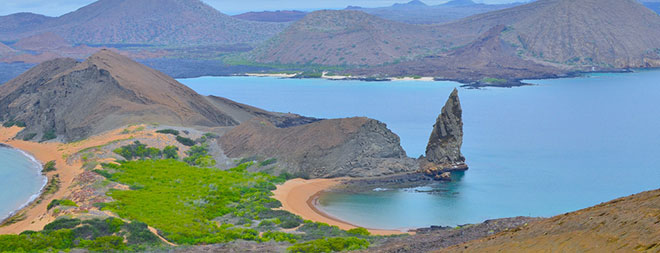Sea Level Shifts Helped Shape Galapagos' Biological Diversity

(Inside Science) -- The birds and reptiles that inhabit the Galapagos Islands famously provided Charles Darwin with key insights into evolution by natural selection, but there's been little research into how the animals came to be distributed across the different islands.
Now, a new study suggests that rising and falling sea levels played a key role in the distribution of species across the Galapagos by repeatedly connecting and then isolating the 16 equatorial islands.
The findings, published online in the Journal of Biogeography on April 23, suggest that over the last half million years, major fluctuations in sea level have regularly reconfigured the Galapagos' geography. This has in turn fundamentally shaped biological evolution on the islands.
Because this mechanism can only have affected a small number of other oceanic island systems around the world, "the Galapagos Islands are more special than was previously thought," said study coauthor Jason Ali, a geoscientist at the University of Hong Kong.
Ali and his collaborator, geoscientist Jonathan Aitchison of the University of Sydney, reached their conclusions after examining the geographical distribution of various land-bound animals that inhabit the Galapagos Islands, including snakes, lizards and land iguanas.
The researchers then created a "palaeogeographical" computer simulation that takes into account recent climatic and geological activity that has affected the local sea level around the islands. The modeling indicates that the geography of the Galapagos Islands was regularly reconfigured over the millennia. For example, the most extreme reductions in sea level would have lowered the shorelines of some islands by up to 690 feet. Such major drops would have caused the islands in the center and western part of the chain to coalesce into a single large "mega" island.
During such reconnection events, Ali said, plants and animals would have been free to move around the new landmass, in some cases mingling their genes, until sea level rise forced them back to higher ground and "genetically trapping" them again for approximately 90,000 years -- the average duration between reconnection events, according to the simulation.
Importantly, the new model can explain a striking pattern seen in the distribution of species across the Galapagos Islands: on the outer islands, a species will typically be found on only one island, but on the central, or "core," islands, a species is usually is present on all of the islands. This pattern is most apparent in the distribution of the Galapagos' racer snakes, lava lizards, land iguanas and geckos.
Interestingly, the Galapagos' legendary giant tortoises are the only reptiles that don't fit this pattern. Ali sees two possible explanations for this curious discrepancy. For one thing, in recent centuries, the tortoises were moved between islands by sailors and pirates for use as food stashes. Secondly, research carried out by molecular biologists indicates that the gene pools of the tortoises are extremely complex. "It suggests that members of the various sub-populations were regularly swimming and floating between islands and thus sharing their genetic material with their closely related neighbors," Ali said.
According to Ali, previous explanations for the biological distribution of the Galapagos did not account for reconnection events, which he said was a fundamental part of the new research.
Ali notes that his mechanism for species distribution is also applicable to a small number of other oceanic island systems around the world -- including portions of the Canary, Cape Verde and Maldives chains -- though "not to the same extent as in the Galapagos, as in each of these other cases far fewer islands were involved."
Geologist Peter Clift of Louisiana State University in Baton Rouge called the reconnection model for the Galapagos a "rather novel concept" and predicted that it will have a significant scientific impact in fields ranging from biology to geology.
"Showing that there are more genetic similarities between animals living on islands that were connected at times of low sea level is an impressive piece of investigative science," he added, "and one that supports the concept of the sea level being an important driver in controlling evolution in these island archipelago settings," said Clift, who did not participate in the research for the study. "In many ways it is surprising that nobody has tried to do this before."
If Ali and Aitchison's model is correct, then it should be testable using genetic techniques. For example, if scientists were to examine the genomes of certain reptiles living in the Galapagos using the phylogenetic tree method, they should find that the structures of their family trees have been strongly imprinted by the sea-level history.
Ker Than is a freelance writer based in the Bay Area. He tweets at @kerthan.
